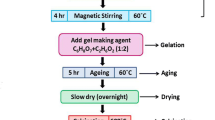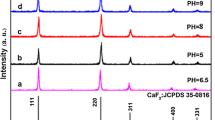Abstract
Highly crystalline, phase pure Cu3P nanocrystals (NCs) have been successfully synthesized using ionic liquid-assisted solvothermal method at relatively low temperature (200 °C). Herein, ionic liquids (ILs) are used as a structure directing/templating agent. Effect of ILs and precursor concentration on crystal phase, crystallite size, lattice strain, morphology and grain size of Cu3P NCs is studied. In the presence of IL, crystallite size and lattice strain significantly change with changing the concentration of red phosphorus. For example, smaller crystallite size (38.5 nm) and compressive lattice strain are obtained when 10 times of red phosphorous is used. However, bigger size (41.9 nm) and tensile lattice strains are obtained for the lower concentration of phosphorous (5 times). At higher phosphorus concentration, hexagonal shaped micro-crystals with prominent grain are observed. HRTEM images reveal that spherical-shaped particles on further agglomeration through Ostwald ripening process form hexagonal-shaped bigger microstructures. However, on doping the rare-earth ions (RE3+ = Ce3+/Tb3+) in the Cu3P NCs show the green luminescence (at 542 nm) which is attributed to the emission of Tb3+ ions. To the best of our knowledge, this is the first report on rare-earth doped Cu3P nanoparticles and shows promise on the luminescence aspect of Cu3P nanomaterials along with its already existing plasmonic and semiconducting properties.
Graphic abstract










Similar content being viewed by others
References
Callejas J F, Read C G, Roske C W, Lewis N S and Schaak R E 2016 Synthesis, characterization, and properties of metal phosphide catalysts for the hydrogen-evolution reaction Chem. Mater. 28 6017
Wei K, Qi K, Jin Z, Cao J, Zheng W, Chen H and Cui X 2016 One-step synthesis of a self-supported copper phosphide nanobush for overall water splitting ACS Omega 1 1367
Du H, Kong R-M, Guo X, Qu F and Li J 2018 Recent progress in transition metal phosphides with enhanced electrocatalysis for hydrogen evolution Nanoscale 10 21617
Sun M, Liu H, Qu J and Li J 2016 Earth-rich transition metal phosphide for energy conversion and storage Adv. Energy Mater. 13 1600087
Miao S, Hickey S G, Rellinghaus B, Waurisch C and Eychmüller A 2010 Synthesis and characterization of cadmium phosphide quantum dots emitting in the visible red to near-infrared J. Am. Chem. Soc. 132 5613
Greuters J and Rizvi N 2003 UV laser micromachining of silicon, indium phosphide and lithium niobate for telecommunications applications. In: Thomas J. Glynn (ed.), Proceedings of SPIE Opto-Ireland 2002: Optics and photonics technologies and applications Vol. 4876
Luber E J, Mobarok M H and Buriak J M 2013 Solution-processed zinc phosphide (α-Zn3P2) colloidal semiconducting nanocrystals for thin film photovoltaic applications ACS Nano 7 8136
Bhushan M and Catalano A 1981 Polycrystalline Zn3P2 Schottky barrier solar cells Appl. Phys. Lett. 38 39
Bachmann K J 1981 Properties, preparation, and device applications of indium phosphide Annu. Rev. Mater. Sci. 11 441
Bera D, Qian L, Tseng T K and Holloway P H 2010 Nanocrystals for thin film photovoltaic applications quantum dots and their multimodal applications: a review Materials 3 2260
Wolff A, Pallmann J, Boucher R, Weiz A, Brunner E, Doert T and Ruck M 2016 Resource-efficient high-yield ionothermal synthesis of microcrystalline Cu3−xP Inorg. Chem. 55 8844
Hao J, Yang W, Huang Z and Zhang C 2016 Superhydrophilic and superaerophobic copper phosphide microsheets for efficient electrocatalytic hydrogen and oxygen evolution Adv. Mater. Interfaces 3 1600236
Shen R, Xie J, Ding Y, Liu S-y, Adamski A, Chen X and Li X 2019 Carbon nanotube-supported Cu3P as high-efficiency and low-cost cocatalysts for exceptional semiconductor-free photocatalytic H2 evolution ACS Sustain. Chem. Eng. 7 3243
Kong M, Song H and Zhou J 2018 Metal–organophosphine framework-derived N,P-codoped carbon-confined Cu3P nanopaticles for superb Na-ion storage Adv. Energy Mater. 8 1801489
Hua S, Qu D, An L, Jiang W, Wen Y, Wang X and Sun Z 2019 Highly efficient p-type Cu3P/n-type g-C3N4 photocatalyst through Z-scheme charge transfer route Appl. Catal. B 240 253
Zheng H, Huang X, Gao H, Lu G, Dong W and Wang G 2019 Cu@Cu3P Core–shell nanowires attached to nickel foam as high-performance electrocatalysts for the hydrogen evolution reaction Chem. Eur. J. 25 1083
Wang R, Dong X-Y, Du J, Zhao J-Y and Zang S-Q 2018 MOF-Derived Bi-functional Cu3P nanoparticles coated by a N, P-Co-doped carbon shell for hydrogen evolution and oxygen reduction Adv. Mater. 30 1703711
Wolff A, Doert T, Hunger J, Kaiser M, Pallmann J, Reinhold R, Yogendra S, Giebeler L, Sichelschmidt J, Schnelle W, Whiteside R, Gunaratne H Q N, Nockemann P, Weigand J J, Brunner E and Ruck M 2018 Low-temperature tailoring of copper-deficient Cu3−xP-electric properties, phase transitions, and performance in lithium-ion batteries Chem. Mater. 30 7 111
Manna G, Bose R and Pradhan N 2013 Semiconducting and plasmonic copper phosphide platelets Angew. Chem. 125 6894
Kristensen A, Yang J K, Bozhevolnyi S I, Link S, Nordlander P, Halas N J and Mortensen N A 2017 Plasmonic colour generation Nat. Rev. Mater. 2 16088
De Trizio L, Gaspari R, Bertoni G, Kriegel I, Moretti L, Scotognella F and Marras S 2015 Cu3-xP nanocrystals as a material platform for near-infrared plasmonics and cation exchange reactions Chem. Mater. 27 1120
Stan M C, Klöpsch R, Bhaskar A, Li J, Passerini S and Winter M 2013 Cu3P binary phosphide: synthesis via a wet mechanochemical method and electrochemical behavior as negative electrode material for lithium-ion batteries Adv. Energy Mater. 3 231
Barry B M and Gillan E G 2008 Low-temperature solvothermal synthesis of phosphorus-rich transition-metal phosphides Chem. Mater. 20 2618
Wang X, Han K, Gao Y, Wan F and Jiang K 2007 Fabrication of novel copper phosphide (Cu3P) hollow spheres by a simple solvothermal method J. Cryst. Growth 307 126
Liu J, Meyns M, Zhang T, Arbiol J, Cabot A and Shavel A 2018 Triphenylphosphite as the phosphorus source for the scalable and cost-effective production of transition metal phosphides Chem. Mater. 30 1799
Bol A A, van Beek R and Meijerink A 2002 On the incorporation of trivalent rare earth ions in II–VI semiconductor nanocrystals Chem. Mater. 14 1121
Chen W, Bovin J O, Joly A G, Wang S g, Su F and Li G 2004 Full-color emission from In2S3 and In2S3:Eu3+ nanoparticles J. Phys. Chem. B 108 11927
Hu H and Zhang W 2006 Synthesis and properties of transition metals and rare-earth, metals doped ZnS nanoparticles Opt. Mater. 28 536
Kenyon A J 2002 Recent developments in rare-earth doped materials for optoelectronics Prog. Quantum Electron. 26 225
Sharma R K, Mudring A-V and Ghosh P 2017 Recent trends in binary and ternary rare-earth fluoride nanophosphors: How structural and physical properties influence optical behavior J. Lumin. 189 44
Ghosh P, Sharma R K, Chouryal Y N and Mudring A-V 2017 Size of the rare-earth ions: a key factor in phase tuning and morphology control of binary and ternary rare-earth fluoride materials RSC Adv. 7 33467
Ghosh P and Patra A 2005 Understanding the influence of nanoenvironment on luminescence of rare-earth ions PRAMANA J. Phys. 65 901
Dahl J A, Maddux B L S and Hutchison J E 2007 Toward greener nanosynthesis Chem. Rev. 107 2228
Sharma R K, Chouryal Y N, Chaudhari S, Saravanakumar J, Dey S R and Ghosh P 2017 Adsorption-driven catalytic and photocatalytic activity of phase tuned In2S3 nanocrystals synthesized via ionic liquids ACS Appl. Mater. Interfaces 9 11651
Weingärtner H 2008 Understanding ionic liquids at the molecular level: facts, problems, and controversies Angew. Chem. Int. Ed. 47 654
Marsh K N, Boxall J A and Lichtenthaler R 2004 Room temperature ionic liquids and their mixtures—a review Fluid Phase Equilib. 219 93
Sharma R K, Nigam S, Chouryal Y N, Nema S, Bera S P, Bhargava Y and Ghosh P 2019 Eu-Doped BaF2 nanoparticles for bioimaging applications ACS Appl. Nano Mater. 2 927
Sharma R K, Chouryal Y N, Nigam S, Saravanakumar J, Barik S and Ghosh P 2018 Tuning the crystal phase and morphology of the photoluminescent indium sulphide nanocrystals and their adsorption-based catalytic and photocatalytic applications ChemistrySelect 3 8171
Parnham E R, Slawin A M Z and Morris R E 2007 Ionothermal synthesis of β-NH4AlF4 and the determination by single crystal X-ray diffraction of its room temperature and low temperature phases J. Solid State Chem. 180 49
Arco S D, Laxamana R T, Giron O D and Obliosca J M 2009 Synthesis of [RMIM] acetate halogen-free ionic liquids for use as greener solvents in Diels-Alder reaction Philipp. J. Sci. 138 133
Acknowledgements
The authors would like to acknowledge for financial support from the Science and Engineering Research Board (SERB) and Board of Research in Nuclear Sciences (BRNS), Government of India. The authors acknowledge Sophisticated Instrumentation Centre (SIC) for SEM, and Department of Chemistry for PXRD analysis. The authors also acknowledge the AIIMS New Delhi for TEM characterization support from PURSE programme sanctioned by Department of Science and Technology (DST), Govt of India.
Author information
Authors and Affiliations
Corresponding author
Additional information
Special Issue on Materials Chemistry
Electronic supplementary material
Below is the link to the electronic supplementary material.
Rights and permissions
About this article
Cite this article
CHOURYAL, Y.N., SHARMA, R.K., ACHARJEE, D. et al. Influence of ionic liquids and concentration of red phosphorous on luminescent Cu3P nanocrystals. J Chem Sci 131, 93 (2019). https://doi.org/10.1007/s12039-019-1665-y
Received:
Revised:
Accepted:
Published:
DOI: https://doi.org/10.1007/s12039-019-1665-y




